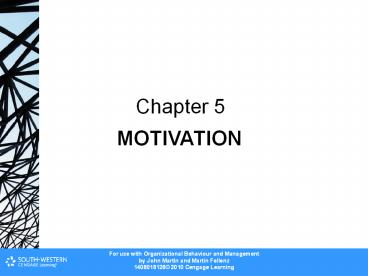MOTIVATION - PowerPoint PPT Presentation
Title:
MOTIVATION
Description:
Chapter 5 MOTIVATION Motivation and performance Motivation - the force that initiates, directs and sustains behaviour Ability - the capacity of individuals to achieve ... – PowerPoint PPT presentation
Number of Views:431
Avg rating:3.0/5.0
Title: MOTIVATION
1
Chapter 5
MOTIVATION
2
Motivation and performance
Motivation - the force that initiates, directs
and sustains behaviour Ability - the capacity of
individuals to achieve the tasks they are trying
to accomplish Opportunity - the conditions under
which motivation and ability are deployed
3
Basic motivational process
Add Figure 5.1 here
4
Motivation in organizations
Motivation explains three important aspects of
deliberate behaviour Direction - the type of
activity chosen to be engaged with Effort - the
amount of energy expended in relation to a
particular activity Persistence - the duration
of the behaviour in question, especially in light
of difficulties or obstacles
5
Intrinsic and extrinsic motivation
- Intrinsic motivation - the impetus for behaviour
originates in the performance of the action
itself, such as an enjoyable or otherwise
satisfying task - Extrinsic motivation - the impetus for behaviour
originates outside the person and the performed
task, it is done as a means to another end
6
Content theories of motivation
Maslows hierarchy of needs theory Alderfers
existence, relatedness and growth theory
(ERG) Herzbergs two-factor theory
7
Maslows hierarchy of needs
- Individuals have innate needs or wants which they
will seek to satisfy - Physiological needs
- Safety needs
- Social needs
- Esteem needs
- Self-actualization needs
8
Maslows hierarchy of needs
- Hierarchy displays the following properties
- A need once satisfied is no longer a motivator
- A need cannot be effective as a motivator until
those before it in the hierarchy have been
satisfied - If deprived of the source of satisfaction from a
lower order need it will again become a motivator - There is an innate desire to work up the
hierarchy - Self-actualization is not like the other needs
9
Maslows hierarchy of needs
- Figure 5.2
10
Alderfers ERG theory
- Three-level hierarchy
- Existence needs
- Relatedness needs
- Growth needs
11
Herzbergs two-factor theory
- Motivators and hygiene factors
- Hygiene factors if absent cause dissatisfaction
- Salary
- Working conditions
- Job security
- Level and quality of supervision
- Company policies and administrative procedures
- Interpersonal relationships at work
- Motivators - motivate an individual to improve
their work performance - Recognition
- Sense of achievement
- Responsibility
- Nature of the work itself
- Growth
- Advancement
12
Comparison of the needs theories
Figure 5.3
13
Satisfaction and Herzbergs two factors
- Figure 5.4
14
Process theories
Vroom Porter and Lawler expectancy models Adams
equity theory Lockes goal theory
15
Vrooms expectancy model
- Figure 5.5
16
Porter and Lawler expectancy model
- Figure 5.6
17
Adams equity theory
- Relative fairness of treatment at work
- Equity/Inequity
Figure 5.7
18
Lockes goal setting theory
- Intentions play a significant part in behavioural
patterns - Feedback
- Goal setting needs
- Specifics
- Completion requirement
- Difficult goal/easy goals
Figure 5.8
SMART objectives
19
BEHAVIOURIST THEORIES
- Pavlov and classical conditioning
- Skinner and operant conditioning
20
Pavlov and classical conditioning
- Figure 5.9
21
The four central processes used in operant
conditioning
- Figure 5.10
22
RECENT CONTRIBUTIONS TO WORK MOTIVATION
- Banduras Social-Cognitive Theory
- Important aspects of this theory include
- the notion of vicarious learning
- dynamics of self-control (absent from
behaviouristic views of behaviour) - the concept of self-efficacy
- Self-Determination Theory
- distinguishes between
- autonomous motivation (where behaviour is based
on volition and active choice) - controlled motivation (where behaviour is based
on external consequences determined by decisions
or dynamics outside the person)
23
Continuum of self-determination according to SDT
- Table 5.1































